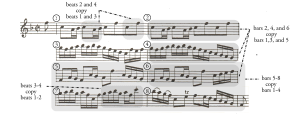Letting the famousness, the brightness, the radiance of Bach’s second Brandenburg Concerto speak for itself, we can take a moment to explore a few of its patterns — to look at a few of the mirrors and mechanisms of its brilliance. They are a source of pulse, resonance and meaning. They are a bit amazing.
A quick investigation of the first phrase can help bring light to the entire work. Here it is (reduced to its principal line):
It’s weirdly simple. Bars one and two are exactly the same. Bars three and four are exactly the same, except for a few transitional notes at the end. Bars five and six are exactly the same, except for a few transitional notes at the end. The seventh bar can be divided into two identical halves, except for a transitional note at the end. The eighth bar stands alone. And the basic rhythms of the second four bars echo the rhythm of the first four.All this repetition drives one to want more, to extrapolate. And there is more — it’s already there, even (you can interpolate, too). On a small scale, bar 1 consists of two repeated figures, and more and more rhymes between the bars appear the longer you look at them.
Connecting the material of these first eight bars we will hear, again and again, a kind of confirmation of its cadence leading back to the material of bar 1:
There is a kind of dizzying clarity — a memorable and useful kind of simplicity. Things do get more complicated (and less formulaic), but the basic measure remains: things happen in twos. Canons, fugue entrances, even the binary nature of solo/tutti seems to play a role: there are four solo voices, and four tutti voices (cello/bass/continuo count once). (If that seems a stretch, compare the 3rd Brandenburg Concerto, where everything comes in threes…)
The third movement is built from the same material at its opening, re-barred, making still another kind of copy:
Meanwhile, above all this duplicating and binary fragmenting, stands the heroic role of the trumpet, first among the four soloists. When patterns threaten to become merely repetitive, the trumpet becomes tuneful and linear over the mechanics of the main material, pulling everyone forward. Over and over, it comes to the rescue. The role of the trumpet is also materially heroic — it plays fantastically high, and what it plays is very, very, very difficult. Amidst all the possible abstractions, there is the brilliance of the trumpet, bringing something simple and proud enough to have served, back in the day, as one of the anthems of American conservatism (at the opening of William F. Buckley’s Firing Line).

